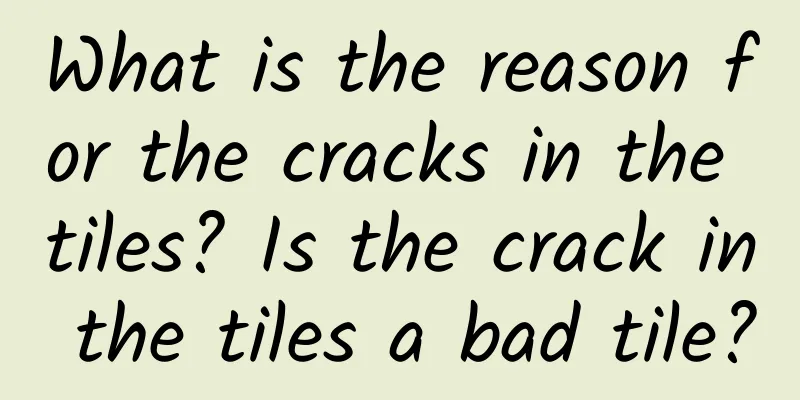What is the reason for the cracks in the tiles? Is the crack in the tiles a bad tile?

|
We all know that ceramic tiles are a common decoration material, and almost all homes have ceramic tiles. Some people will find cracks in the tiles after installing them for a period of time. This is a common phenomenon. So what are the reasons for the cracks in the tiles? Let's take a closer look! What causes cracks in tiles?1. Reasons for tile qualityAlthough tiles are inspected and qualified when they are processed and shipped out of the factory and have no problems with their own quality, they will be moved and transported many times from the factory to various dealers and then to the distributors below. Although the tiles are also packaged and protected, it does not mean that the tiles will not be damaged due to transportation and moving, and some tiles will not have internal damage in this process. The damage can be seen directly, but the tiles with internal damage cannot be seen at the time, and the master cannot check it when laying the tiles. After the laying is completed, the tiles will crack due to the adhesive materials and external forces. In this case, the cracks in the tiles are due to the quality of the tiles themselves. 2. Tiles soaked in water and not properly maintainedPasting tiles is a technical job, which everyone knows. Different tiles need to be pasted in different ways. Tiles with cracks are often clay tiles. This kind of tiles need to be soaked in water before pasting, and sprinkled with water for maintenance after laying. Only in this way can the pasted tiles have no quality problems. If the tiles are not soaked in water for a long time before laying, and the tiles are laid, quality problems will arise later; similarly, after the tiles are laid, if they are not sprinkled with water for maintenance, problems will occur in the pasted tiles, and these quality problems may be tile cracks. 3. Problems with pasting materialsDifferent types of tiles have different requirements for pasting materials. Normally, clay tiles use 32.5-grade cement, and the instructions for use of tiles also indicate that only this grade of cement is the best pasting material for clay tiles. However, during the decoration process, some owners are afraid that the 32.5-grade cement for pasting tiles is not enough, so they use higher-grade cement for pasting. This will cause the shrinkage coefficient of the cement to be unequal to that of the tiles. In addition, the high-grade cement is not equal to the cement of the original wall, which will cause cracks in the tiles. If it is an ordinary wall, it will also show cracks on the wall. 4. Affected by external forcesAfter the tiles are laid, if the location of the cracks is a newly built wall, then the force of the wall sinking will stretch the tiles to form cracks. In addition, due to the renovation of the wall and the neighbors next door, the location of the cracks may have more grooves in the renovation next door, and the vibration force of the grooves will reduce the bearing capacity of the wall, which will also cause cracks in the tiles. Solutions to cracked tilesRegardless of the cause of the cracks, if there are many cracks, it is recommended to replace the cracked tiles to ensure the overall aesthetic effect. If only one tile has cracks, you can also ask professional tile repairers to come and repair the cracks. After the repair, the cracks will not be visible at all. At the same time, pay attention to the following points when laying tiles: It is very important to treat the base before laying tiles. First, check whether the base is hollow, and then check whether the cement grade of the base wall meets the standard. If all indicators are unqualified, then before laying tiles, the area where the tiles are to be laid must be fully treated. There are temperature requirements for tile laying. When the room temperature is below 5°C, the tiles cannot be laid to avoid affecting the firmness of the tiles. Before laying tiles, the base needs to be wetted to ensure a humidity of 30%-70%, and to ensure that the adhesive material is naturally dried rather than quickly dried to avoid affecting the quality of laying. When laying tiles, you must leave gaps. It is recommended to leave a gap of 1.5-3mm. Because the specifications of tiles cannot be 100% the same, and the expansion coefficient of tiles varies greatly due to thermal expansion and contraction, so leaving gaps is a kind of protection for tiles. How to choose the best tiles1. When choosing tiles, you must be clear about where the tiles you buy will be used, because different places will use different tiles. Tiles are mainly divided into more than four types, so before choosing, you must choose according to your needs. 2. There are many grades of tiles, and the prices of high-grade and low-grade tiles are naturally very different. Of course, the higher the price, the better the relative quality, and it is also environmentally friendly and pollution-free, but you need to choose according to your own consumption level. 3. When choosing tiles, you should not only choose according to your own preferences and tastes, but also consider whether the style and color of the tiles are consistent with the interior decoration style. Because there are many types and colors of tiles, you must consider the overall quality when purchasing them, and they must match the home decoration style. |
>>: Is alum root a perennial plant? What kind of soil is best for growing alum root?
Recommend
Is it safe to have a period a few days after your period?
For women with normal menstrual cycles, the safe ...
How long does it take for vaginal tear stitches to heal?
Problems with the genitals can cause extremely se...
How to prevent further calcification of the placenta
Some pregnant women may experience premature plac...
What are the differences between freshly ground coffee and instant coffee? How can you tell the difference between freeze-dried and fog-dried instant coffee?
Coffee essence is a kind of artificially synthesi...
Mid-term Down syndrome screening
Down syndrome screening is a test that every preg...
Is it dangerous to have the umbilical cord around the neck for two weeks?
It is actually quite common for pregnant women to...
What are the dangers of insomnia during the month?
After expectant mothers give birth to their babie...
Will frequent uterine contractions at 35 weeks lead to premature birth?
The normal pregnancy period should be ten months....
Can menopausal morning stiffness heal itself?
When women reach around 45-55 years old, they wil...
What causes vaginal bleeding after sex?
Generally speaking, normal and coordinated sexual...
How much do you know about cognitive impairment after stroke?
Stroke is a disease with high morbidity, disabili...
TSMC's 2nm trial production yield has reached 60%, and it is expected that the monthly production capacity will reach 50,000 wafers by the end of 2025
TSMC's plan to quickly deliver the first 2nm ...
Is it normal to have cloudy amniotic fluid at 38 weeks of pregnancy?
The symptom of turbid amniotic fluid in pregnant ...
The left ovarian artery comes from
The uterus and ovaries are very important for wom...
This virus has entered its peak period, the latest reminder from the China Centers for Disease Control →
The peak season for norovirus infection is from O...









